ANTI-SOCIAL WEEDS
Best Worst in my Gardens
Do your weeds socialize? Mine mostly do not. That’s at least true for summer’s worst weeds. Each has seemingly staked out its territory in various of my gardens or parts of gardens, and keeps there mostly to itself.
The all-time biggest offender has been Canadian thistle (Cirsium arvense). Its bristly stems and leaves have insinuated themselves all over the place to the west of our main vegetable garden, in among a hogepodge of berry plants. How clever of them, especially getting in there among the gooseberries, where it’s hard enough to pull them from amongst the clusters of berrty stems, and made moreso by gooseberry’s spines.
One control — not cure, though — for the thistle invasion is mulch. Because of thistle’s deep, energetic, errant roots, just any mulch will not do.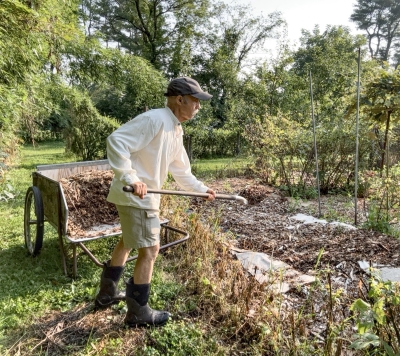 So I’ve resorted, hopefully just for this year, to laying down corrugated cardboard topped with arborist wood chips, a technique beloved to permaculturalists and historically loathed by me.
So I’ve resorted, hopefully just for this year, to laying down corrugated cardboard topped with arborist wood chips, a technique beloved to permaculturalists and historically loathed by me.
Why the loathing? There’s the glue — probably not good for the soil — that holds the cardboard together but, more important, the cardboard takes a long, long time to decompose. During that time, a wood chip mulch without cardboard could be decomposing, its lower portions melding with, and imparting its goodness, to the soil. That cardboard layer could also render the covered soil gasping for air.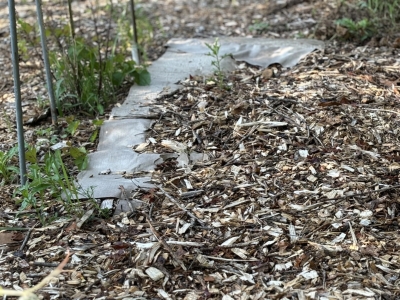
No matter; paraphrasing Hippocrates, writing over 2000 years ago, drastic situations must have drastic remedies. Perhaps if I am sufficiently diligent with followup — that is, merely pulling stems — remediation will exist. I actually had a more sedate thistle invasion decades ago, cured at that time by, along with a helper, diligent and repeately pulling out thistle stems.
A nearby offender to the thistles, and sometimes visited by a few thistles, is creeping Charlie (aka ground ivy or, botanically, Glechoma hederacea). 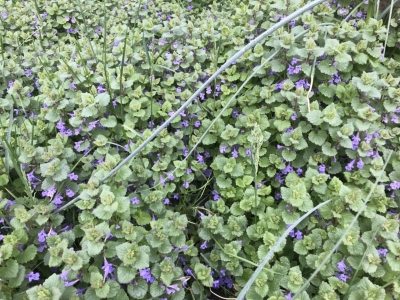 It especially enjoys the dappled shade beneath a bed in which grows a row of pear trees. In the past, I would try to keep creeping Charlie out of the bed by just grabbing at clumps trying to creep in.
It especially enjoys the dappled shade beneath a bed in which grows a row of pear trees. In the past, I would try to keep creeping Charlie out of the bed by just grabbing at clumps trying to creep in.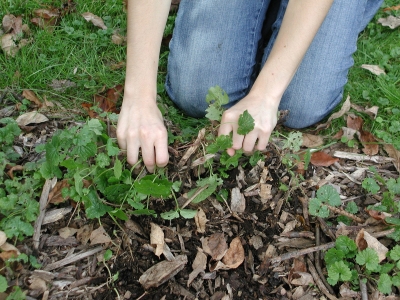 At that time the bed was home to quite a few thistles. I’ve let that bed go, and now the ground is a verdant carpet of mostly creeping Charlies — quite attractive. Perhaps the creeping Charles are offering the thistles a less than cordial welcome.
At that time the bed was home to quite a few thistles. I’ve let that bed go, and now the ground is a verdant carpet of mostly creeping Charlies — quite attractive. Perhaps the creeping Charles are offering the thistles a less than cordial welcome.
This morning I scythed the creeping Charlie to keep it from getting too, too agressive and creeping into the adjacent vegetable garden.
Pretty and Edible, But . . .
The next culprit in order of best/worst weed is groundnut (Apios americana). The plant, with golfball-size tubers stringing like beads along a plant root, was responsible for getting the pilgims through their first winter.  A researcher in Louisiana was trying to revive interest in the plant; I became interested and wrote away for seeds.
A researcher in Louisiana was trying to revive interest in the plant; I became interested and wrote away for seeds.
Long story short: I received the seeds which grew into plants which I set in my perennial flower bed. I take all blame for having to repeatedly pull plants every year for the last few decades to keep the vines from smothering other plants and spreading to my nearby, sacred blueberries.
There was some rationale for planting groundnut in the flower bed. The dense racemes of pinkish-purple flowers are attractive and waft the scent of chocolate. The taste of the tubers? Meh.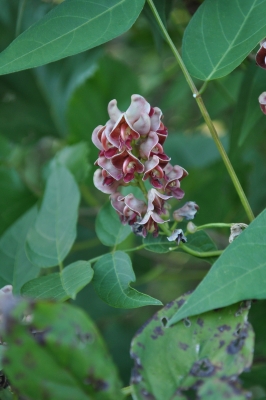
Mulching, Of Course
Moving across a small expanse of lawn to a wood chipped (no cardboard) bed of black currants and black raspberries, we look down at the ground and see wild morning glory (field bindweed, Convolvulus arvensis). Like the annual, blue-flowered morning glories than I grow, wild morning glory is a twining vine with pretty flowers, usually white tinged with blue. The wild one is perennial with very deep, traveling roots.
Wild morning glory doesn’t flower in the black raspberry/black currant garden because I’m constantly pulling out small plants that pop up through the mulch or try to climb the fence that encloses that bed.
I do lots of mulching with arborist wood chips, which is effective against many weeds — obviously excluding thistles and wild morning glory. I like arborist wood chips because it’s mostly weed-free and mostly free, and because it makes use of a “waste” product.
A load of chips last year proved not to be weed-free. It contained small pieces of of poison ivy stems which sprouted and attempted to establish themselves over the ground beneath my asparagus. 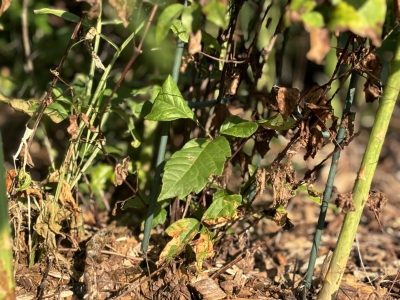 Poison ivy is hard enough to remove by hand, and especially so from beneath a mature stand of tall asparagus stems.
Poison ivy is hard enough to remove by hand, and especially so from beneath a mature stand of tall asparagus stems. 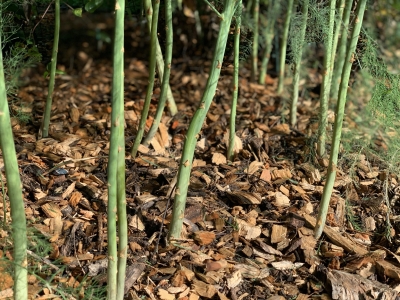 But the poison ivy is totally under control now — more on that in a bit.
But the poison ivy is totally under control now — more on that in a bit.
Ways with Weeds
A weed has been defined as a plant growing where it’s not wanted. Of course, a real weed is more than just that. That unwanted plant must also be very vigorous and very clever in the way it spreads. Addressing the first requirement, tomato seeds often survive the heat of composting, so might show up where that compost is spread but tomato plants not wanted. These plants are easily remove and then gone. Clever weeds, though, might spread be via underground runners (quackgrass), prolific seed production (pigweed), and/or seeds that remain viable in the soil for a long time (lambsquarters, ragweed, and wouldn’t you know it — wild morning glory and Canada thistle).
Control of any weed is geared to their method(s) of propagation. I do just pull lots of weeds. I also hoe weeds, expecially small ones if the day is warm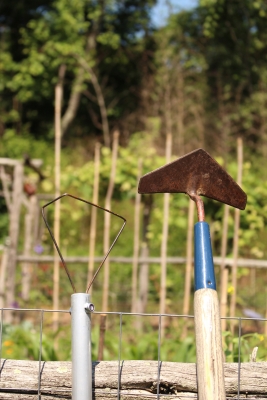 and sunny and the soil is not to dry or moist. Hoeing is easy, newer types — the winged weeder and the wire weeder are my favorites — not demanding the proverbial “iron back with a hinge in it. Just skim either of these hoes slightly below the soil surface. It’s quick an satisfying.
and sunny and the soil is not to dry or moist. Hoeing is easy, newer types — the winged weeder and the wire weeder are my favorites — not demanding the proverbial “iron back with a hinge in it. Just skim either of these hoes slightly below the soil surface. It’s quick an satisfying.
One of my current favorite methods of weeding involves herbicide — no, wait, I haven’t gone over to the dark side. I’m talking about relatively benign plant killers, herbicides that are even approved for certified organic agriculture. I used to make my own with household strength vinegar with a little canola oil and soap added.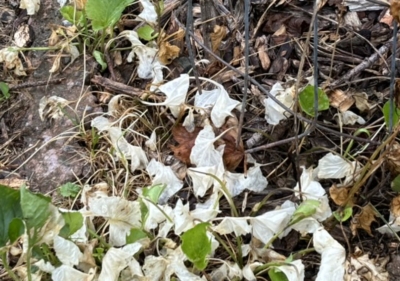
That “almost salad dressing” herbicide was somewhat effective but I’ve since graduated to a more effective commercial product, Biosafe. The active ingredient, ammonium nonanoate, is also found in other commercial organic herbicides an is merely the ammonium salt of a fatty acid. Essentially a soap.
The limitation of Biosafe and similar organic herbicides is that they are most effective at warm temperatures (above 70°F) and with sunny weather. They only kill foliage, so applications must be repeated to weaken weeds to death. And the upper leaves of large weeds can create a shadow effect with spray, preventing it from reaching lower, sheltered leaves.
On the plus side, Biosafe is very effective a knocking down thistle, poison ivy, and wild morning glory. Pretty much all green parts of plants, it seems. I find herbicide applications also useful along the base of a fence, where weeds insinuate themselves and are hard to pull or cut.
Whether just pulling weeds, hoeing them or using any other weeding method, most important in keeping weeds at bay is to do so regularly. Small weeds are much easier to deal with than the same plants when they grow up, fuller with leaves, more tenaciously rooted, and perhaps already spreading their ill will with seeds or underground runners slyly advancing.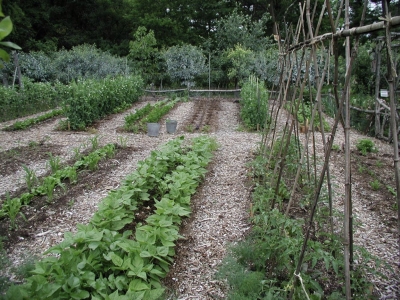


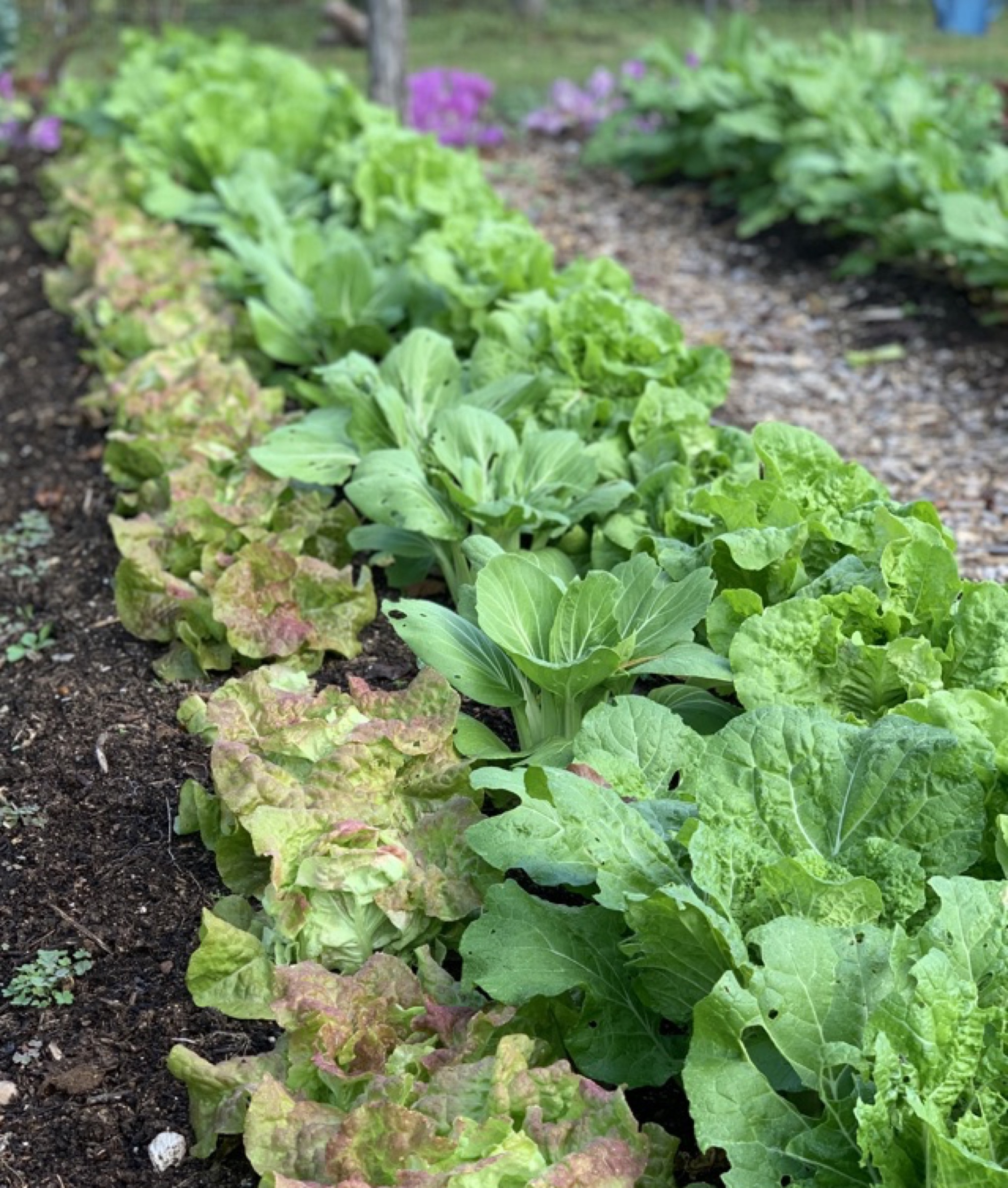
I’m in the South and really struggle with Bermuda grass. It can grow down into the soil at least a foot so if you are looking on the surface you might think it’s not invading. Any organic suggestions on how to control this in a no-till garden?
Some sort of solid barrier as I described to another reader’s question.
Lee, I’d like to add a solid barrier along my metal fence to keep both weeds and wildlife that might dig under my fence. I’m considering rolls of 8” or 10” metal or similar sized plastic or vinyl landscape edging. I’d bury 6” below ground and 2-4” above ground to help keep weeds out. Your thoughts ???
I like the idea and am considering it for my garden. I would put it a foot down (easy here because no rocks) and 6″ or more above ground. If you also have a wire fence, weeds will insinuate themselves between the fence and the barrier. I think the easiest way to deal with them would be periodic spraying with an organic herbicide.
Consider heavy plastic tree root barriers, meant to keep tree roots form growing under and lifting sidewalks. You could also purchase it from nurseries that sell bamboo.
Hi Lee–
I love your posts– and your books!
Question: What plant do you mean by “pigweed”? I’ve heard this name given to lamb’s quarters (Chenopodium album) and also to purslane (Portulaca oleracea), but my searches also gave me something similar to lamb’s quarters but with a smooth edged leaf that is also an amaranth. I love eating both lamb’s quarters and purslane. I consider them crops, not weeds!
[I just found a “fun fact”: According to the “Encyclopedia of American Food and Drink,” the name “lamb’s quarters” is derived from the name of an ancient English festival called “Lammas quarter,” (from Old English hlāfmæsse, “loaf-mass”) the first harvest festival of the year, held in August. It had nothing to do with lambs, but rather blessing bread at Mass.]
I was referring to red-root pigweed which, yes, is also a species of amaranth, Amaranthus retroflexus.
Interesting origin of the name “lamb’s quarters.” Thanks.
Mugwort. It demands every single method you mention! I’ve pulled the young stems in the Spring; knocked over older stems then covered with cardboard and weighed it down with compost and municipal mulch; tried cutting it down and spraying stems with herbicide (a very tedious temporary obnoxious “solution” also in the organic gardening repertoire); and of course pulling seedlings asap. I have to live with it in certain places but I have told it in no uncertain terms it is not allowed free reign any more. And so my gardens are free of it now and it took years, as you say! And will continue to!
Love your posts, Lee. Always learn something. Thank you for your writing!
Mugwort: I cut it back and hoed it back, and now periodic spray with Biosafe gets all the little ones trying to emerge. All this is in path of vegetable garden. Any mugwort that makes it further, into a bed, I hand pull, repeatedly.